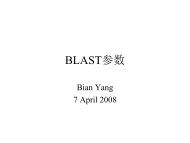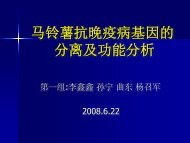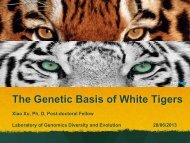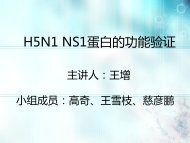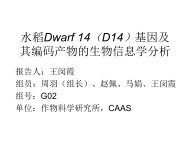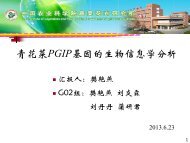Environmental connections of novel avian-origin H7N9 influenza ...
Environmental connections of novel avian-origin H7N9 influenza ...
Environmental connections of novel avian-origin H7N9 influenza ...
Create successful ePaper yourself
Turn your PDF publications into a flip-book with our unique Google optimized e-Paper software.
8 Li J, et al. Sci China Life Sci June (2013) Vol.56 No.6protein affect the growth <strong>of</strong> <strong>influenza</strong> viruses in mammaliancells [68]; namely, positions 627 (PB2-627) and 701(PB2-701). In most human <strong>influenza</strong> viruses the residue atposition 627 is lysine (PB2-627K) and in most <strong>avian</strong> virusesit is glutamic acid (PB2-627E). Thus, 627K in PB2 is amammal-signature amino acid. The alignments <strong>of</strong> the publiclyavailable <strong>H7N9</strong> PB2 sequences revealed that the PB2sequence from a human sample <strong>of</strong> the Zhejiang/DTID-JU01 virus had a 627E substitution (Figure 4). TheZhejiang/DTID-ZJU01 virus also had a special D701N mutationwhich was confirmed previously to be important forthe high virulence <strong>of</strong> this virus in animal models [8,15].Together, these data for the different important amino acidsubstitutions in the proteins <strong>of</strong> <strong>novel</strong> <strong>H7N9</strong> viruses indicatea divergent adaption mode for the <strong>influenza</strong> A virus in human[16,17].The genotypic diversities <strong>of</strong> the <strong>novel</strong> <strong>H7N9</strong> viruses thatwe sequenced from the patients and the contact poultrymarket in Hangzhou, Zhejiang Province implied that these<strong>novel</strong> viruses exhibited rapid evolution. The results <strong>of</strong> thisstudy may shed light on the understanding <strong>of</strong> the source andmode <strong>of</strong> transmission <strong>of</strong> these infections, and will provide areference for the considerate selection <strong>of</strong> candidate vaccinestrains.This work was supported by the Hangzhou Key Medicine Discipline Fundfor Public Health Laboratory sponsored by the Hangzhou government,National Basic Research Program <strong>of</strong> China (2010CB530303, 2011-CB504703), and an intramural special grant for <strong>influenza</strong> virus researchfrom Chinese Academy <strong>of</strong> Sciences (KSZD-EW-Z-002). We thank Dr. GaoGeorge F. for his advice on the design <strong>of</strong> this study and for his criticalreview for the manuscript. We also thank the staff <strong>of</strong> the MicrobiologyLaboratory <strong>of</strong> Hangzhou Center for Disease Control and Prevention fortheir excellent technology support, and Dr. Zhu Dan for his interpretation<strong>of</strong> the patients’ radiographs. The authors declare no financial or commercialconflict <strong>of</strong> interest.1 Gao R, Cao B, Hu Y, et al. Human infection with a <strong>novel</strong><strong>avian</strong>-<strong>origin</strong> <strong>influenza</strong> A (<strong>H7N9</strong>) virus. N Engl J Med, 2013, doi:10.1056/NEJMoa13044592 Liu D, Shi W, Shi Y, et al. Origin and diversity <strong>of</strong> <strong>novel</strong> <strong>H7N9</strong> <strong>avian</strong><strong>influenza</strong> viruses causing human infection. Lancet, 2013, doi:10.1016/S0140-6736(13)60938-13 Kageyama T, Fujisaki S, Takashita E, et al. Genetic analysis <strong>of</strong> <strong>novel</strong><strong>avian</strong> A(<strong>H7N9</strong>) <strong>influenza</strong> viruses isolated from patients in China,February to April 2013. Eurosurveillance, 2013, 18: pii=204534 Herfst S, Schrauwen E J, Linster M, et al. Airborne transmission <strong>of</strong><strong>influenza</strong> A/H5N1 virus between ferrets. Science, 2012, 336: 1534–15415 Imai M, Watanabe T, Hatta M, et al. Experimental adaptation <strong>of</strong> an<strong>influenza</strong> H5 HA confers respiratory droplet transmission to areassortant H5 HA/H1N1 virus in ferrets. Nature, 2012, 486: 420–4286 Li Z, Chen H, Jiao P, et al. Molecular basis <strong>of</strong> replication <strong>of</strong> duckH5N1 <strong>influenza</strong> viruses in a mammalian mouse model. J Virol, 2005,79: 12058–120647 Shinya K, Hamm S, Hatta M, et al. PB2 amino acid at position 627affects replicative efficiency, but not cell tropism, <strong>of</strong> Hong KongH5N1 <strong>influenza</strong> A viruses in mice. Virology, 2004, 320: 258–2668 Steel J, Lowen A C, Mubareka S, et al. Transmission <strong>of</strong> <strong>influenza</strong>virus in a mammalian host is increased by PB2 amino acids 627K or627E/701N. PLoS Pathog, 2009, 5: e10002529 Bao Y, Bolotov P, Dernovoy D, et al. The <strong>influenza</strong> virus resource atthe national center for biotechnology information. J Virol, 2008, 82:596–60110 Rodriguez F, Oliver J L, Marin A, et al. The general stochastic model<strong>of</strong> nucleotide substitution. J Theor Biol, 1990, 142: 485–50111 Stamatakis A. RAxML-Vi-HPC: maximum likelihood-based phylogeneticanalyses with thousands <strong>of</strong> taxa and mixed models. Bioinformatics,2006, 22: 2688–269012 Jonges M, Meijer A, Fouchier R A, et al. Guiding outbreakmanagement by the use <strong>of</strong> <strong>influenza</strong> A(H7Nx) virus sequenceanalysis. Eurosurveillance, 2013, 18: pii=2046013 Russell C A, Fonville J M, Brown A E, et al. The potential forrespiratory droplet-transmissible A/H5N1 <strong>influenza</strong> virus to evolve ina mammalian host. Science, 2012, 336: 1541–154714 Fouchier R A, Garcia-Sastre A, Kawaoka Y, et al. Transmissionstudies resume for <strong>avian</strong> flu. Science, 2013, 339: 520–52115 Chen Y, Liang W, Yang S, et al. Human infections with the emerging<strong>avian</strong> <strong>influenza</strong> A <strong>H7N9</strong> virus from wet market poultry: clinicalanalysis and characterisation <strong>of</strong> viral genome. Lancet, 2013, doi:10.1016/S0140-6736(13)60903-416 Quynh M L, Sakai-Tagawa Y, Ozawa M, et al. Selection <strong>of</strong> H5N1<strong>influenza</strong> virus PB2 during replication in humans. J Virol, 2009, 83:5278–528117 Li Q, Zhou L, Zhou M, et al. Preliminary report: epidemiology <strong>of</strong> the<strong>avian</strong> <strong>influenza</strong> A (<strong>H7N9</strong>) outbreak in China. N Engl J Med, 2013,doi: 10.1056/NEJMoa1304617Open Access This article is distributed under the terms <strong>of</strong> the Creative Commons Attribution License which permits any use, distribution, and reproductionin any medium, provided the <strong>origin</strong>al author(s) and source are credited.Supporting InformationTable S1 Clinical features <strong>of</strong> the patients on admissionTable S2Molecular analysis <strong>of</strong> amino acid difference in the viral proteins between Hangzhou/1 isolate and other three reported <strong>H7N9</strong> virusesThe supporting information is available online at life.scichina.com and www.springerlink.com. The supporting materialsare published as submitted, without typesetting or editing. The responsibility for scientific accuracy and content remains entirelywith the authors.



